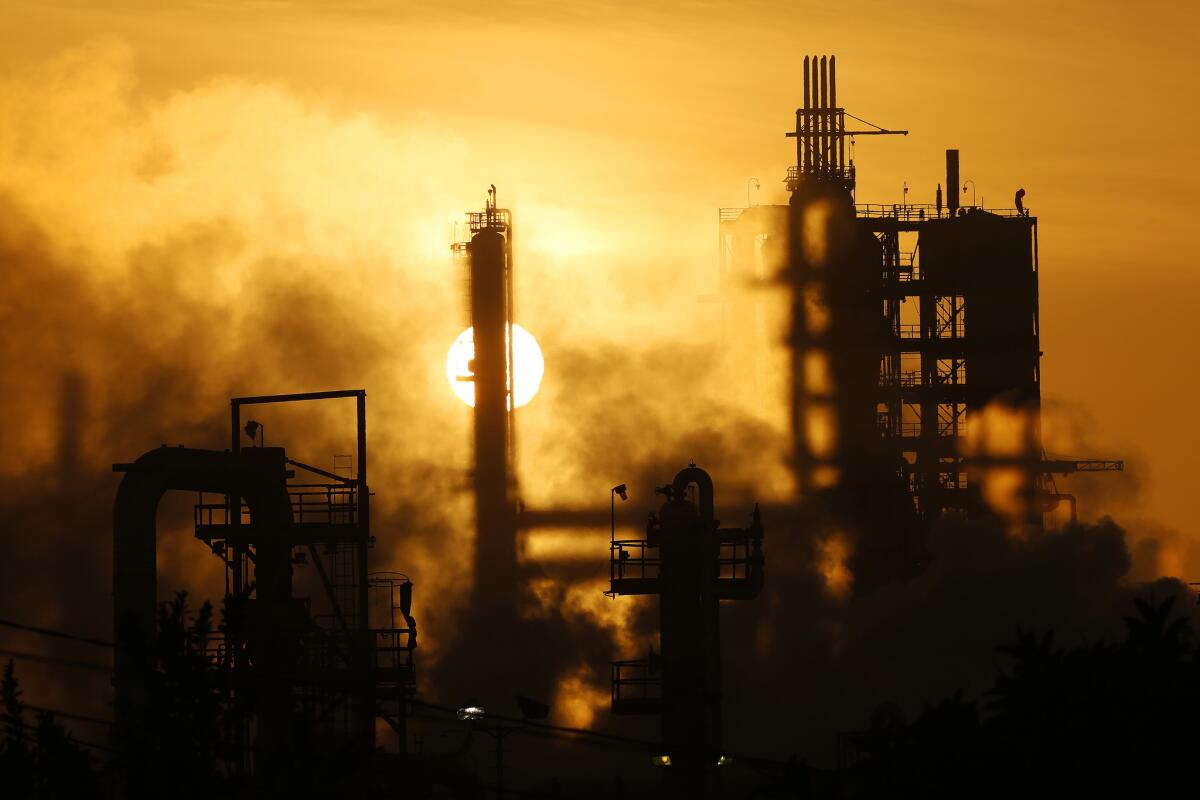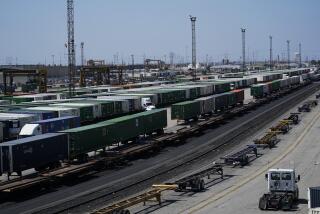After criticism, SoCal air board adds more regulatory teeth to smog-reduction plan

Southern California air quality officials released a proposal Friday to give more regulatory teeth to a smog-reduction plan that has faced criticism for its voluntary, industry-friendly approach.
The South Coast Air Quality Management District has revised a plan, originally released in June, to include additional regulations to cut emissions from diesel backup generators, water heaters, furnaces and other appliances. Among other changes, the agency also added a commitment to identify and consider new measures targeting oil refineries, ports, warehouses and other large facilities that are responsible for much of the pollution in the nation’s smoggiest region.
The changes come in response to what regulators acknowledge was a skeptical reaction to their first draft of the plan, which relies heavily on voluntary, “nonregulatory” measures that encourage, rather than force, polluters to adopt cleaner technology. The document, which will guide efforts to reduce pollution levels in Southern California over the next 15 years, calls for finding $1 billion a year for emissions-cutting incentive programs — a 10- to 20-fold increase over what is spent today.
Though the overall approach remains similar, language in the revised plan emphasizes that the agency “will make full use of its legal authorities to seek a cleaner air future” and will give priority to “maximizing emissions reductions” using battery, fuel cell and other zero-emissions technologies where possible.
The new plan also proposes giving “serious consideration” to ending a cap-and-trade program for smog-forming emissions from the region’s largest facilities and adopting traditional regulations in its place. The current program requires polluters to buy credits to cover their emissions, which is intended to provide a financial incentive to clean up their operations.
The Regional Clean Air Incentives Market, or RECLAIM program, has come under fire recently for failing to reduce nitrogen oxide emissions to the extent promised. Partly to blame is an oversupply of credits, which has allowed oil refineries and other large polluters to delay installing costly pollution controls.
Last December the AQMD board adopted oil industry-backed changes to the program that will cut less pollution and more slowly than agency staff had proposed. That decision has faced harsh criticism from state regulators and environmentalists, who say it violated state law and will hurt public health.
The AQMD proposal released Friday acknowledges that “many of the program’s original advantages appear to be diminishing and generating increased scrutiny” and suggests that an “orderly sunset” of the program may be the best way to reduce burdens on businesses while achieving greater emissions reductions.
The changes to the plan, presented at a governing board meeting in a ballroom at the Mission Inn Hotel & Spa in Riverside, were greeted with skepticism and protest from environmentalists. They urged stronger measures to reduce smog-forming pollution, particularly from ports, rail yards, warehouses and other hubs of the bustling goods movement and logistics industry.
Outside the meeting, Sierra Club activists from the Inland Empire, some in ghoulish masks and costumes, staged a Halloween-themed demonstration to demand tougher action against the “deadliest air in the nation.”
The inland region suffers from the nation’s highest levels of ozone, the lung-damaging gas in smog.
“We want a strong plan that is very regulatory and not just asking folks to volunteer to clean up the air,” said Mary Valdemar, a Sierra Club member from San Bernardino. “We’re past the point of being nice.”
Southern California’s polluted air is linked to thousands of premature deaths, emergency room visits and missed school days a year from asthma, heart disease and other illnesses. A recent analysis by the South Coast district found that the health benefits of meeting federal pollution-reduction deadlines would far outweigh the billions in costs to industry, the government and consumers.
Driving the plan is a 2031 federal deadline to reduce ozone pollution. Achieving that will require massive reductions in smog-forming nitrogen oxides, largely from trucks, trains, cargo ships and other transportation-related sources that release the bulk of the pollution in the South Coast region, which includes 17 million people across Los Angeles, Orange, Riverside and San Bernardino counties.
Expected later this month is a proposal that will detail how smog-reduction projects outlined in the agency’s plan would be paid for. One funding source under consideration by air district officials is an increase in vehicle registration fees of as much as $30 to $60 a year.
But any attempt to raise fees on millions of drivers faces serious obstacles, including a requirement that it be approved on a two-thirds vote in the state Legislature. State Senate Leader Kevin De León (D-Los Angeles) opposes the idea and has called it “a cynical attempt by polluters to shift the burden of cleaning up after themselves to middle- and working-class families.”
A final version of the smog-reduction plan is expected to go to the air-quality board for adoption by February 2017.
tony.barboza@latimes.com
More to Read
Sign up for Essential California
The most important California stories and recommendations in your inbox every morning.
You may occasionally receive promotional content from the Los Angeles Times.











